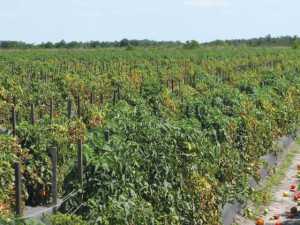Tomato Diseases On The Rise In Absence Of Methyl Bromide

Fusarium wilt symptoms are apparent in this Florida tomato field.
Photo courtesy of Gary Vallad
Well into the methyl bromide phase-out, soilborne pathogens are building up and creating more disease problems. During the 2013 Florida Ag Expo, Dr. Gary Vallad, a plant pathologist with UF/IFAS, outlined some disease challenges tomato growers are facing in the absence of methyl bromide. Showing attendees a picture of a tomato field infested with classic fusarium wilt symptoms, he said this is becoming a more frequent sight across the state.
“Back when I started with UF/IFAS in 2007, the only time I would see these yellow plants (fusarium wilt symptoms) was typically at the end of rows where too little methyl bromide went out because they turned off the fumigant too soon at the end of a row,” he said. “But starting three or four years ago, I began getting calls about these more uniformly diseased fields.”
The intensity of fusarium wilt is increasing. Vallad discussed a field from the previous spring that had 30% incidence of wilt at the first pick. By the second pick, it had grown to 80%, with some areas a complete loss.
“We have seen an expansion of the area impacted as well,” he said. “Where we used to have growers report a concentrated problem area in one field, now they are reporting it popping up in many different areas and fields.”
Another problem on the rise is fusarium crown/root rot. Vallad described the level of infestations in some tomato fields in Manatee County in fall 2013 as “shocking.” Even with the standard methyl bromide replacement in use, growers were seeing 10% to 30% incidence by the first pick with the disease growing progressively worse with each picking.
“While there are resistant varieties for both fusarium wilt and crown/root rot, they are susceptible to bacterial spot and fruit are typically smaller than the standards growers are used to,” he said.
According to Vallad, research activities include trying to identify the weaknesses in the current methyl bromide alternatives. “We are looking to develop additional strategies for managing soilborne pathogens to augment fumigation,” he said. “This might include different cultural practices, weed management strategies, and maybe modifying bed architecture.”
Thanks to DuPont Crop Protection for sponsoring Florida Ag Expo Extended Coverage.









